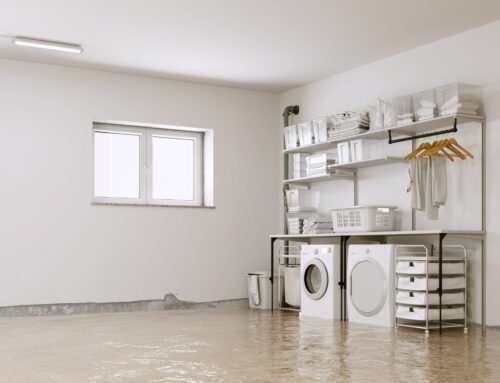A geologist would tell you that plain old water is actually one of the most powerful elements on earth. It can erode the hardest stone, turning jagged mountains into rolling hills over the centuries. In the space of just a few years, it can carve away the earth, changing the flow and location of rivers. So just imagine what kind of damage water, in its many forms, could do to the walls and foundation of your home if you’re not prepared and protected.
Water leaks around your home can cause serious damage within a relatively short amount of time. While you might imagine that Alberta’s relatively dry climate would result in less to worry about on the moisture front, the opposite is actually true; our drier environment helps create conditions that make it easy for water and moisture to infiltrate your home’s structure and wiring, sometimes causing damage where you least expect it.
Nowhere in Canada experiences the same variation in climate and annual precipitation levels that we do in Alberta — even more reason for you to pay close attention to water entering your home.
If even a little water is finding its way inside, it’s essential to catch it quickly, before it becomes a burdensome and destructive issue. Luckily, we’ve got the solutions and tips that will help prevent water damage in your home, so you can stay dry and safe all year-round.
Let’s start with something small that can cause a big problem.
Manage your home’s humidity
Condensation on interior windows occurs naturally when sufficiently humid interior air comes into contact with a cold window surface, and is a sure sign your home’s overall humidity is too high.
Here are some tips to keep your home’s humidity in check:
- Ensure your home is properly ventilated, especially around areas where condensation is most likely to occur.
- Open your curtains and blinds during the day; keeping them closed increases the likelihood of condensation forming.
- Adjust the output of your home’s humidifier to 20 – 25% on the coldest winter days.
- If you see condensation accumulating on your windows, run a dehumidifier or ventilation fan to help remove unwanted moisture from your home.
- Just as you would run the defroster in your car, you should turn on ceiling fans throughout your home and run exhaust fans as needed to remove excess moisture.
- Make sure to keep your fans on during cooking, bathing, cleaning and painting, and leave them on for a minimum of 60 minutes afterwards.
- Ensure you are using and properly maintaining your HRV or Principle Ventilation Fan
Check for attic rain
During extended cold weather, moisture can enter your attic space and attach to your roof sheathing or trusses as frost or ice, especially if your home is particularly humid. When the temperature rises above freezing, or if the temperature rises on an intensely sunny day, that same frost can melt faster than your attic’s ventilation system can vent the moisture, occasionally causing it to drip onto surfaces underneath. If this occurs, you may see wet spots or stains on your ceiling, or water leaks around a window or at the bottom of a wall.
This attic rain can cause significant problems in some cases, but can be managed by keeping the humidity in your home at 20-25%, and by turning on vent fans when cooking or showering. If you do see attic rain, do not open your attic access to try to dry the space out; this actually allows more humidity into your attic, exacerbating the situation.
Practice ongoing general home maintenance
Maintaining your home’s fixtures and plumbing systems is essential, as leaks in fixtures or plumbing components can cause serious issues if not corrected. Check your faucets, sinks drains, toilets, hot water tanks and sump pump drains carefully to ensure they’re not leaking water onto floors or into wall.
If your concrete driveway is pitted or cracked, large pools of water — particularly those close to your home – can seep into the ground around your foundation, causing problems. Seal or patch cracks as they appear.
Your roof is one of the home’s most essential maintenance concerns, so you should regularly check for loose or broken shingles, repairing or replacing them as soon as possible to prevent leaks from entering your attic. Also check around skylights and satellite dishes or other attachments, ensuring stands, fixtures and screws are properly waterproofed.
Understand landscaping and water drainage
Landscaping, while enhancing your home’s beauty and value, can also adversely affect its integrity if not installed and managed correctly. Before you plant trees or build gardens and water features, consider the topography, size and layout of your yard. Planning and maintaining your landscaping is an essential part of keeping your home safe from water.
A nice lawn doesn’t just make your home look and feel welcoming; it also helps to prevent soil erosion and water damage. Grass and planting beds require proper drainage slopes to move water away from your home.
Manage surface water
Alberta receives approximately 355 mm (14 inches) of rain between May to October. On a typical 40′ x 110′ residential lot, this amounts to approximately 31,900 gallons (144,800 litres) of water. If any of this water finds its way into your home, it can cause thousands of dollars in damage. Unquestionably, proactive management of surface water can make a world of difference.
When the soil around your home settles, it can begin to slope towards the foundation, and water could eventually enter your basement. You can grade soil away from your home to encourage proper drainage; a three-meter slope with about a 15-centimeter drop is a safe start, and should keep surface water moving away from your home. If you see water collecting, consider installing a gravel trough or French drain in the area to direct surface water away (but ensure your local building codes allows it first.)
Also check your foundation for cracks and spaces both inside and out; patch cracks with hydraulic cement to create a watertight seal. Alternatively, waterproof sealants can be brushed or sprayed onto foundation walls to create a rubber-like, impermeable water barrier.
Make sure window wells aren’t filled with standing water that can seep in through the window frame. Install window well liners to hold back water, and also covers that act as ‘umbrellas’ to direct water away.
A key to minimize unwanted water moisture in the home is comprehensive surface water management.
Waterproof your basement
As an extra line of defense against unwanted moisture, waterproof coatings can be applied indoors, over the cement or concrete blocks making up your foundation wall. They may be specifically manufactured in white or neutral colours for indoor use, but can also easily be painted once applied. These coatings usually dry in roughly three hours, meaning you can apply multiple coats if necessary.
A sump pump draws excess groundwater away from your foundation and directs it to appropriate drain pipes, an absolutely essential fixture if the water table around your home is especially damp.
Maintain your eavestroughs
Eavestroughs allow precipitation to safely move away from your home, onto the ground and away from the structure, keeping water from pooling in areas where it can damage your foundation.
Regularly cleaning debris and leaves from your eavestroughs and downspouts ensures they’re working as intended. Cover your downspouts with plastic or wire mesh strainers where they meet the eavestroughs to keep debris from entering.
Once the eavestroughs and downspouts are free of large pieces of debris, run some water from your hose through them to wash out any remaining dirt or foliage.
Protect your home from cold weather
When the temperature suddenly dips, you need to be prepared. Winterizing your home to protect against Alberta’s harshest weather is a crucial step in keep your home operating smoothly during especially frosty stretches. Don’t be left out in the cold; preparing for a cold snap is surprisingly simple.
Make sure your furnace is switched to ‘on’ and not ‘auto’, and increase your indoor temperature to a comfortable level to ensure the water in your pipes and toilet bowls don’t freeze; poorly insulated water pipes and indoor plumbing could rupture as freezing water expands within them.
Ensure weatherstripping on doors and windows are maintain a tight seal against the outside air, and make sure you lower your humidifier to 20 – 25%.
Run your bathroom fans for up to 60 minutes after a shower and make sure your kitchen fan is on while cooking to draw out excess moisture.
Drain and turn off your external water supply taps and ensure exterior vents and intake valves are clear of debris and build up.
When the cold snap passes, do a visual inspection of the exterior of your home to look for and address any issues that may have appeared.
Prevent ice dams
Ice dams, instantly recognizable ice buildup along the lower edge of your roofline, can block your eavestroughs, and cause significant damage to your shingles, gutters, attic and more.
When shingles are warmed by direct sunlight, that heat combines with warmer air under your roof, causing snow to melt and trickle down to your eaves (which have a generally cooler surface temperature). This water can re-freeze instead of draining away, letting ice gradually build up and become an ice dam. Take precautions to avoid these nuisances by insulating the inner surface of your roof, and by let cool air circulate around your attic; make sure your ceilings adjacent to the attic are well insulated.
Enjoy worry-free home ownership
Habitual, ongoing care and attention makes it a breeze to stay on top of the many considerations that affect moisture levels in and around your home. With time and ongoing preventive maintenance to protect your investment, you will see your worries about water in your home simply evaporate!







Excellent post ANHWP team! I totally agree with all points listed. In several of the examples listed, it would be worth having an extractor fan that comes with a humidity sensor as well as an overrun timer. These two features would massively help reduce moisture in the air on autopilot!
[…] you can imagine, there are many indications you have moisture management issues on your property; leaks or flooding in your basement, pooling water on your lawn, powdery […]
is attic rain covered under your new home warranties?
Hi Sara, thanks for your question. Attic rain can be caused by many different factors, some of which are covered, and others (such as humidity management) is the responsibility of the homeowner. We recommend you contact our team (1.800.352.8240) to walk through your unique situation and advise next steps.